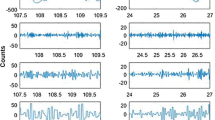Abstract
The problem of automatic detection of seismic waves by large telemetered seismic networks such as the Mexican Continental Aperture Seismic Network (RESMAC), is extended here to include determination of seismic first-arrival and S-phase-arrival times. A short general outline of the detection problem background and a small introduction to the autoregressive model (AR) concept are presented. Several automatic detection algorithms were implemented and compared with a newly developed autoregressive algorithm. Careful consideration of the advantages and disadvantages of each method determined that a mixed detection scheme is optimal and suitable for RESMAC. A few examples are shown that illustrate the relative performances of the methods tried here. The proposed detection scheme has the following characteristics: (a) First-arrival detection, based on a simple (average of squared input) characteristic function, and a trigger criterion that uses as a distortion measure the long-average-to-short-average ratio of the characteristic function, checked using a duration criterion; (b) use of two threshold values, one for triggering, and another for beginning the backward search for the phase arrival time; (c) use of the autoregressive model (AR) method, with the Itakura-Saito distortion measure, for S-phase detection, checked using both duration and amplitude criteria; and (d) characterization of the reliability of the determinations for their subsequent use in automatic location programs, alarms, etc. The automatic detection scheme has proved effective.
Similar content being viewed by others
References
Allen, R., 1978, Automatic Earthquake Recognition and Timing from Single Traces: Bull. Seismol. Soc. Amer., v. 68, no. 5, p. 1521–1532.
Allen, R., 1982, Automatic Phase Pickers: Their Present Use and Future Prospects: Bull. Seismol. Soc. Amer., v. 72, no. 6, p. S225-S242.
Anderson, K., 1977. Automatic Analysis of Microearthquake Network Data,in Proceedings of the International Symposium on Computer Aided Seismic Analysis and Discrimination, June 1977, p. 40–51.
Basseville, M. and Benveniste, A., 1983, Sequential Detection of Abrupt Changes in Spectral Characteristics of Digital Signals. IEEE Trans. Inform. Theory, v. IT-29, no. 5, p. 709–724.
Bodenstein, G. and Praetorius, H., 1977, Feature Extraction from the Encephalogram by Adaptive Segmentation, Proceed. IEEE, v. 65, no. 5, p. 642–652.
Goforth, T. and Herrin, E., 1981, An Automatic Seismic Signal Detection Algorithm Based on the Walsh Transform: Bull. Seismol. Soc. Amer., v. 71, no. 4, p. 1351–1360.
Gray, R., Buzo, A., Gray, A., and Matsuyama, Y., 1980, Distortion Measures for Speech Processing: IEEE Trans. Acoust. Sig. Proc., v. ASSP-28, no. 4, p. 367–376.
Lee, W. and Stewart, S., 1981, Principles and Applications of Microearthquake Networks: Academic Press, New York, 293 p.
Lomnitz, C. and Gil, J., 1976, RESMAC: The New Mexican Seismic Array: EOS, v. 57, p. 68–69.
Makhoul, J., 1975, Linear Prediction: A Tutorial Review: Proceed. IEEE, v. 63, no. 4, p. 561–580.
McEvilly, T. and Majer, E., 1982, ASP: An Automated Seismic Processor for Microearthquake Networks: Bull. Seismol. Soc. Amer., v. 72, no. 1, p. 303–325.
Michael, A., Gildea, S., and Pulli, J., 1982, A Real-Time Digital Seismic Event Detection and Recording System for Network Applications: Bull. Seismol. Soc. Amer., v. 72, no. 6, p. 2339–2348.
Papoulis, A., 1981, Max. Entropy and Spectral Estimation. IEEE Trans. Acoust. Speech Sig. Process., v. ASSP 29, no. 6, p. 1176–1186.
Segen, J. and Sanderson, A., 1980, Detecting Changes in Time Series: IEEE Trans. Inf. Theory, v. IT26, no. 2, p. 249–255.
Stewart, S., 1977, Real Time Detection and Location of Local Seismic Events in Central California: Bull. Seismol. Soc. Amer., v. 67, no. 2, p. 433–452.
Yi, T., 1985, Detection Automatica de Ondas Sismicas y el Metodo AR: B.S. Thesis, Fac. Ingenieria, UNAM, 61 p.
Author information
Authors and Affiliations
Rights and permissions
About this article
Cite this article
Yi, T., Nava, F.A. Automatic seismic wave detection and autoregressive model method. Math Geol 20, 37–48 (1988). https://doi.org/10.1007/BF00903187
Received:
Accepted:
Issue Date:
DOI: https://doi.org/10.1007/BF00903187




